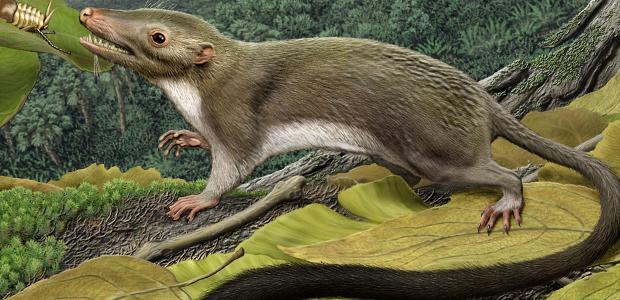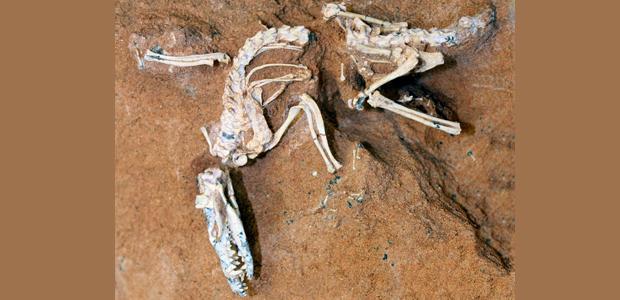The first branch from the tree of life has been placed online by an international team of researchers and used to describe the mother to them all
This rodent-like creature is the oldest mother to have young that weren’t hatched from eggs or raised in pouches – a branch of life that includes humans and more than 5,000 other creatures.
The international team of researchers describing her with such high precision haven’t even met her, but, they know she sat at the base of her branch, ate insects and couldn’t have weighed more than 245 grams – about the size and weight of a pop can after a third of it has been enjoyed.
“This is the first time we’ve seen the era of big data come to anatomy,” Maureen O’Leary, study co-author and paleontologist at Stony Brook University, told SciFare.com. “For a long time, a lot of us worked in small teams, in our own labs or even on our own.”
The researchers know the shape of her brain too and can even make inferences about her young – born one at a time, blind and hairless – along with their father, who produced sperm with a flat head.
They developed their portrait after logging more than 4,500 individual characteristics from 86 different creatures – roughly half were fossil representatives – using a program called Morphobank. It’s designed to aggregate all the fossil and genetic information that’s spread across the scientific record.
“[It] allowed us to work in real-time, over the web and collect data together,” O’Leary said. “That’s what really broke open our ability to assemble so much information.”
About a third of the characteristics they logged were from teeth. Thanks to their enamel coating, they’re often the best evidence researchers have that a creature even existed.
“The number of teeth that mammals have varies quite a bit and changes through evolution,” O’Leary said. “By looking at a combination of developmental data and really interesting fossils, we were able to endorse what had been proposed, even as much as a century ago, about how marsupial and placental teeth compare.”
Fortunately for researchers, the fossil of our theoretical mother’s closest relative – a shrew-like creature called Ukhaatherium nessovi – was unearthed in the Gobi Desert, providing a fossil snapshot for them to work from too.
In addition to a plethora of images, the researchers were also able to log the expertise and context required to analyze the sheer amount data – it’s about ten times larger than any previous analysis!
“Anatomical experts often took their work to the grave,” O’Leary said. “What we’re trying to do is put that information in databases on the web so that we’re leaving an enriched legacy of terminology and labelled features.”
The teeth may provide researchers with a map that documents the evolution to bats, cats and whales, but, the researchers say it’s the loss of a set of bones – known technically as epipubic bones – that mark the shift and rise of placental mammals.
“They’re strange to us, but, they’re small bones that are just in front of the pelvis,” O’Leary said. “They’re found in the Gobi Desert fossils but they would not be found in the placental ancestor.”
These creatures don’t start showing up in the fossil record until after the Cretaceous-Paleogene boundary – a black layer of earth that marks the extinction of all non-avian dinosaurs – when roughly 70 per cent of all creatures disappeared from it.
When the first DNA evidence was published about placental mammals though, it led researchers to believe they roamed the Earth roughly 36 million years earlier than the fossil record has evidence for – alongside the dinosaurs.
It also led them to think the burst recorded was related to the breakup of Pangaea and the subcontinent it produced, Gondwana.
This extended analysis, researchers say, shows the burst’s related to placental mammals moving into niches once dominated by the dinosaurs – well after South America split away from Gondwana – leaving researchers to start telling the story of how the largest branch of mammals went on to re-colonize the planet.
“In a short period of time in the Palaeogene, there would have had to have been some interesting dispersal events for placental mammals, across the globe,” O’Leary said.
One journey they’re challenged with explaining is the story of Afrotheria. It’s also a story that interests Christine Janis, a Vertebrate Paleontologist from Brown University, who wasn’t involved in the study.
“I’m for anything that will promote morphology over molecules,” Janis told SciFare.com. “Morphology can have its problems, but, it can also have its good points.”
Their modern day representatives only reside in Africa, but, older fossils of the common ancestor to elephants and aardvarks were unearthed in South America. This study begins to piece together their journey back home – one she says confirms that it began and ended after Gondwana broke up.
“You really cannot assume that the vicarian breakup of Gondwana has anything to do with the distribution of mammals,” Janis, who’s also a co-author of the textbook, Vertebrate Life, said.
Because there are no fossils of placental mammals before Cretaceous-Paleogene boundary – like the DNA studies say there should be, her team calculated the odds that archaeologists had missed their presence entirely.
In the manuscript her team published in a 1999 issue of the journal, Science, they found that case to be unlikely.
“We know a lot about mammals in the Cretaceous and none of them fit with the modern groups,” Janis said.
The ancestor researchers describe arose between 200,000 and 400,000 years after the extinction event.
What’s cool is that this new research has the potential to simultaneously make molecular dating smarter. Researchers calibrate their dating models using the fossil record, so, having it assembled in one place may allow them to generate models that might finally put a meaningful time stamp to the fossil record.
The new research was published in the journal, Science.
 Science Fare Media Science News – Upgraded
Science Fare Media Science News – Upgraded



